
Merry Meet & Welcome
herb list a-c
A | B | C | D | E | F | G | H | I | J | K | L | M
N | O | P | Q | R | S | T | U | V | W | X | Y | Z Back to Herbs Main Acacia
Acacia dealbata seedsAcacia seeds are often used for food and a variety of other products. In Burma, Laos and Thailand, the feathery shoots of Acacia pennata (common name cha-om, and su pout ywet in Burmese) are used in soups, curries, omelettes, and stir-fries. In Mexico the seeds are known as Guajes. Guajes or huajes are the flat, green pods of an acacia tree. The pods are sometimes light green or deep red in color—both taste the same. Guaje seeds are about the size of a small lima bean and are eaten raw with guacamole, sometimes cooked and made into a sauce. They can also be made into fritters. The ground seeds are used to impart a slightly garlicy flavor to a mole called guaxmole (huaxmole). The dried seeds may be toasted and salted and eaten as a snack referred to as "cacalas". The predominantly herbivorous spider Bagheera kiplingi, which is found in Central America and Mexico, feeds on nubs at the tips of the acacia leaves, known as Beltian bodies, which contain high concentrations of protein. These nubs are produced by the acacia as part of a symbiotic relationship with certain species of ant, which also eat them. Acacia is listed as an ingredient in many soft drinks and lollies. GumVarious species of acacia yield gum. True gum arabic is the product of Acacia senegal, abundant in dry tropical West Africa from Senegal to northern Nigeria. Acacia arabica is the gum-Arabic tree of India, but yields a gum inferior to the true gum-Arabic. Uses in folk medicineAcacia species have possible uses in folk medicine. A 19th-century Ethiopian medical text describes a potion made from an Ethiopian species of Acacia (known as grar) mixed with the root of the tacha, then boiled, as a cure for rabies. An astringent medicine high in tannins, called catechu or cutch, is procured from several species, but more especially from Acacia catechu, by boiling down the wood and evaporating the solution so as to get an extract. The catechu extract from Acacia catechu figures in the history of chemistry in giving its name to the catechin, catechol and catecholamine chemical families ultimately derived from it. Acorns
MythologyThe Norse legend that Thor sheltered from a thunderstorm under an oak tree has led to the belief that having an acorn on a windowsill will prevent a house from being struck by lightning, hence the popularity of window blind pulls decorated as acorns. Magickal UsesOak is an herb of protection, and a fertility herb. Add an Oak acorn to your charm bag to bring fortune and luck, and to promote fertility. Burn Oak bark as an incense to promote protection. Oak is also used in Mabon Ceremonies and in Handfastings. Oaks with Mistletoe growing in them should be left alone regarding harvest, for their spirits lend themselves to ritual work, and to cut them down brings misfortune. The Mistletoe collected from these Oaks is considered to be the most powerful. Oak has long been considered a symbol of fertility. Oak acorns ground into flour make excellent ritual cakes. Oaks and their acorns are highly appropriate for the Hallow's Eve Celebration. In various cultures many believe the Yule Log should be of Oak, and the ashes are gathered and strewn throughout one's land to bring good fortune and wealth in the coming year. The ritual fire for Midsummer should include Oak. Many believe there is no wand as sacred as one made of Oak. Decorate altars with Oak leaves during Lammas and Hallows. Medicinal and Other UsesNative Americans use Oak in many ways, they use the bark medicinally, they grind acorns into flour, and they roast acorns for a drink similiar to coffee. White Oak bark is one of the strongest natural astringent herbs available. Rich in tannins, White Oak bark also provides Vitamin B12, and minerals like Calcium, Iron and Zinc. White Oak bark's astringent properties tighten tissues and strengthen blood vessels, making it ideal for treating diarrhea, hemorrhoids and varicose veins. The blood-clotting agents active in White Oak bark are also helpful to stop nosebleeds. White Oak bark has also been used to treat inflammation and irritations caused by poor digestion, ulcers, strep throat, skin problems, hemorrhoids, hemorrhage, goiter, gall bladder, leucorrhea, jaundice, parasites, ulcers, and varicose veins. Oaks are used for dye, wine barrels, ink, lumber, and the White Oak is one of our most important, largest, longest-lived, and most valuable timber trees in America. Adam & Eve Root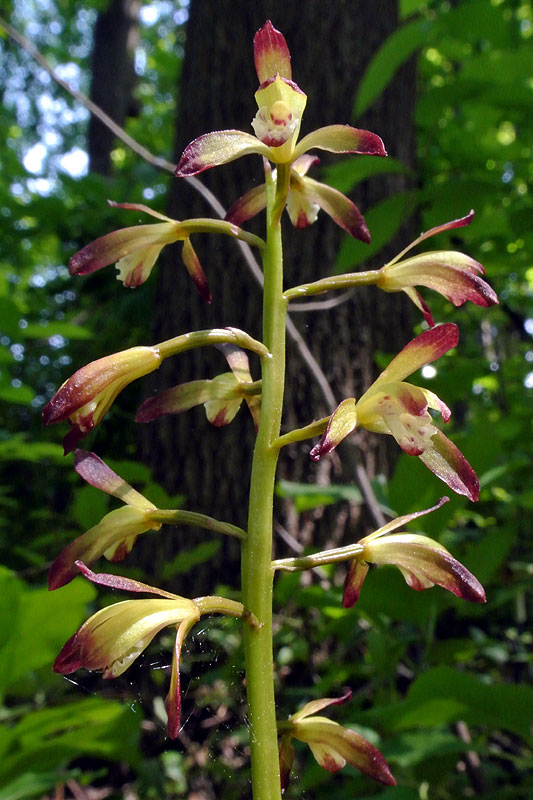 Adam & Eve Root (Aplectrum hyemale): Carried to attract or repel love. Given to a couple to ensure continued happiness. Adam & Eve Root (Aplectrum hyemale): Carried to attract or repel love. Given to a couple to ensure continued happiness.
Medicinal UseThe roots are macerated to a paste and applied to boils or used to treat head pains. A tea made from the roots has been used in the treatment of bronchial troubles. The roots were given to children by some tribes of native North American Indians in order to endow the children with the gift of eloquence and to make them fat. Agrimony
Agrimonia, commonly known as Agrimony, is a genus of 12–15 species of perennial herbaceous flowering plants in the family Rosaceae, native to the temperate regions of the Northern Hemisphere, with one species also in Africa. The species grow to between 0.5–2 m tall, with interrupted pinnate leaves, and tiny yellow flowers borne on a single (usually unbranched) spike. Agrimonia species are used as food plants by the larvae of some Lepidoptera species including Grizzled Skipper (recorded on A. eupatoria) and Large Grizzled Skipper. Medicinal valueAgrimony has a long history of medicinal use. The English poet Michael Drayton once hailed it as an "all-heal," and through the ages it did seem to be a Panacea. The ancient Greeks used Agrimony to treat eye ailments, and it was made into brews to cure diarrhea and disorders of the gallbladder, liver, and kidneys. Anglo-Saxons made a solution from the leaves and seeds for healing wounds; this use continued through the Middle Ages and afterward, in a preparation called eau d'arquebusade, or "musket-shot water". Later, agrimony was prescribed for athlete's foot. In the United States and Canada, and late into the 19th century, the plant was prescribed for many of these illnesses and more: for skin diseases, asthma, coughs, and gynecological complaints, and as a gargling solution for sore throats. Recent authors identify Agrimony as a topical astringent for wounds, ulcers and sore throats and an astringent, bitter tonic, indicated for gastrointestinal and urinary problems such as indigestion, diarrhea and colitis, urinary tract infections, enuresis and incontinence and kidney and bladder gravel. FolkloreAlthough the plant has no idiopathic properties, tradition holds that when placed under a person's head, Agrimony will induce a deep sleep that will last until removed Alfalfa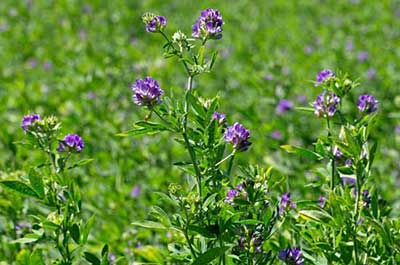
It is used for grazing, hay, and silage, as well as a green manure and cover crop. The name alfalfa is used in North America. The name lucerne is the more commonly used name in the United Kingdom, South Africa, Australia, and New Zealand. Magickal UsesAlfalfa is a bringer of prosperity. Keep in the home to protect from poverty and hunger. It is best placed in in the cupboard or or pantry. Carry it with you when you go to the bank to ask for a loan. To protect your property, burn some alfalfa and scatter the ashes all around its boundaries and buildings. Weave together alfalfa strands to make an amulet to protect against poverty. Add alfalfa to your magical cooking to ward off disease, bring money into the home and when general grounding is desired. Alkanet
This herb's beautiful blue scented flowers appear in late summer; they are full of nectar and attract bees. As shown, the flowers appear in curling spikes that resemble scorpions, and according to Dioscorides, it helped heal the bites of venomous creatures (which are Mars), so consider this herb for protection against magical attack. The dried leaves have a musky fragrance and can substitute for animal musk in incense recipes. Magickal UsesCunningham states that this herb can be burned as an incense against negativity Allspice
The finest allspice is grown in Jamaica but it also grows in several other Central American states including Mexico and Honduras. Magickal UsesAllspice is very uplifting and increases energy and determination making it useful in many different types of spells, especially healing spells. The dried berries, oil, or allspice incense can be burned to aid in spells for attracting money and/or luck. The berries can also be added to sachets for attracting the same. Allspice is useful in all healing mixtures. Burned to attract money or luck, used to promote healing. Almond
"Almond" is also the name of the edible and widely cultivated seed of this tree. Within the genus Prunus, it is classified with the peach in the subgenus Amygdalus, distinguished from the other subgenera by corrugations on the shell (endocarp) surrounding the seed.
Magickal Uses
Almonds and leaves can also be used in charms to draw money or luck. They should be carried in your pocket, purse or wallet (where ever you keep your money) or put in your piggy bank. Almond flowers can be used in hand fasting rituals and love spells to encourage a lasting and loving union and also in adoption rituals. Almond wood, flowers, nuts and leaves can also be used in rituals for overcoming addiction. Especially alcoholism. Althea: Used in protection rites, also good psychic power stimulator. Burn as incense or carry in a sachet. Marshmallow, Mortification Root, Sweet Weed, Wymote, Heemst, Slaz. Alyssum: Used in an amulet to expel charms, also used to moderate anger. Alison, Madwort. Amaranth: Used in healing, protection and invisibility. Flower of Immortality, Love Lies Bleeding, Red Cockscomb, Velvet Flower, Princess Flower, Floramon. Amber: Anemone: Used in health, protection and healing rituals. Grow red anemones in garden to protect both it and the home. Meadow Anemone, Pasque Flower, Passe Flower, Wind Flower. Angelica Root: Used in exorcism, protection, healing and in promoting visions. Archangel, Masterwort, Garden Angelica. Anise Seed: Used to protect from nightmares and in purification baths with Bay Laurel. Anneys, Anise, Yanisin, Sweet Cumin. Apple Leaf: Used in love, healing, garden magick and immortality. Fruit of the Gods, Fruit of the Underworld, Silver Branch, The Silver Bough, Tree of Love. Apricot Leaf: Used in love sachets. Umublinkosi, Xing Ren. Apricot Seed: Carried to attract love. Arbutus: Used for exorcism and protection. Asafoetida: Used for exorcism and protection. Has been known to induce vomiting by inhaling the odor. Assyfetida, Devil's Dung, Food of the Gods, Ungoozeh. Ash Bark: Used in sea rituals, carried to protect from drowining. Nion, Asktroed, Jasen Beli, Freixo. Ash Leaf: Used in pillows to induce prophetic dreams. Aspen Bark: Used in anti-theft spells. European Aspen, Poplar, Quaking Aspen. Aspen Leaf: Used under tounge to become eloquent. Auge Root: Avens: Used in exorcism, purification and love. Assaranaccara, Bennet, Blessed Herb, Clove Root, Colewort, Golden Star, Goldy Star, Hare Foot, Herb Bennet, Minarta, Pesleporis, Star of the Earth, Way Bennet, Yellow Avens. BBalm Of Gilead: Carry to mend a broken heart or attract a new love. Balessan, Balsam Tree, Bechan, Mecca Balsam. Barley: Use the grain or barley water in love spells, may be scattered on ground to keep evil and negativity away. Malt. Basil: Used to soothe tempers between lovers. Also added to love incenses. Alahaca, American Dittany, "Our Herb", St. Joseph's Wort, Sweet Basil, Witches Herb, Njilika, Balanoi, Feslien. Bayberry Root: Bay Laurel: Used for protection, psychic powers, healing, purification and strength. Bay Leaf, Baie, Bay Tree, Daphne, Grecian Laurel, Laurel, Laurier d' Apollon, Laurier Sauce, Lorbeer, Noble Laurel, Roman Laurel, Sweet Bay. Bee Balm: Used to bring clarity and good working order to the surface of any situation. Horsemint, Wild Bergamont, Monarda. Bee Pollen: Bentony (Wood): Burned or grown as a protection and purification herb. Bishopwort, Lousewort, Purple Betony. Benzoin: Burn to purify, often used as a base for incenses. Ben, Benjamen, Gum Benzoin, Siam Benzoin, Siamese Benzoin. Bergamont: Slipped into wallets and purses to attract money. Orange Bergamont, Orange Mint. Bistort: Used for fertility and to improve psychic powers. Dragonwort, Easter Giant, English Serpentary, Osterick, Passions, Patience Dock, Red Legs, Snakeweed, Sweet Dock. Black Mustard: Black Walnut Bark: Black Walnut Leaf: Blackberry Leaf: Used in healing, money and protection rites. Bly, Bramble, Bramble-Kite, Bumle-Kite, Cloudberry, Dewberry, Goutberry, High Blackberry, Thimbleberry. Bladderwrack: Used to give protection to those at sea or over it. Bladder Fucus, Cutweed, Kelp, Sea Spirit, Seawrack, Seetang, Meeriche, Sea Oak, Black Tang. Blessed Thistle: Bloodroot: Carried to draw love or to avert evil spells and negativity. King Root, Red Root, Tetterwort. Boneset: Used in infusions to ward off evil. Augeweed, Crosswort, Feverwort, Indian Sage, Sweating Plant, Teasel, Thoroughwort, Wood Boneset. Borage: Carried for courage. Bugloss, Burrage, Herb of Gladness, Star Flower, Borak, Lisan selvi, Lesan-El-Tour. Bracken: Used in rain magick, burn outside to bring rain. Brazil Nut: Carried as a talisman to bring good luck in love affairs. Bryony: Used to draw money and protect against bad weather. Gout Root, Briony, Ladies' Seal, Mad Root, Snake Grape, Tamus, Tetterberry, Wild Hops, Wild Vine, Wood Vine, English Mandrake. Buchu: Drunk or burned to induce dreams or visions. Bookoo, Bucoo, Buku, Oval Buchu, Short Buchu, Sab, Pinkaou. Buckwheat: Used to attract money and guard against poverty. Beechwheat, Brank, French Wheat, Saracen Corn. Burdock Root: Burned or cast about home to ward off negavitity. Bardana, Beggar's Buttons, Burrseed, Clotbur, Cockleburr, Great Burdock, Happy Major, Hardock, Hurrburr, Personata. Butcher's Broom Root: CCalamus Root: Kept in kitchen to protect against hunger and poverty. Gladdon, Myrtle Flag, Myrtle Grass, Myrtle Sedge, Sweet Cane, Sweet Flag, Sweet Grass, Sweet Root, Sweet Rush, Sweet Sedge, Lubigan. Calendula: Camphor: Hung around neck to prevent colds and flu. Kafoor, Camphire, Chang Nao. Caraway Seed (Black): Used to guard against theft. Kummel, Alcaravea. Caraway Seed (Brown): Used to guard against theft. Kummel, Alcaravea. Cardamon Pods: Used in lust and love potions. Carnation Petal: Used for healing. Gillies, Gilliflower, Jove's Flower, Nelka, Scaffold Flower, Sops-In-Wine. Carob: Carried to maintain good health and guard against evil. Caaroba, Caroba, Carobinha, Chocolate. Carrot Seeds: Eaten to promote pregnancy. Bird's Nest, Philtron, Gizri, Queen Ann's Lace. Cascara Sagrada: Used for legal matters. Sacred Bark, Bitter Bark, Ecorce Sacree, Yellow Bark, Cittim Bark. Cashew Nut: Used in prosperity and money spells. Mbiba, Kasui, Mkanju. Castor Bean: Used to absorb evil. Palma Christi, Palms Christi Root, Mamona, Makula Kula, Mbono, Mdogo, Racznick. Catnip: Used for cat magick, also in love sachets. Cat, Catmint, Catnep, Catrup, Cat's Wort, Field Balm, Nepeta, Nip. Cat's Claw Bark: Cedar: Used for love sachets. Cedar Bark: Used for incense. Celandine: Used to protect from entrapment. Celydoyne, Chelidoninum, Devil's Milk, Garden Celandine, Kenning Wort, Swallow Herb, Swallow-Wort, Tetterwort. Celery Seed: Chewed to aid in concentration, or to induce sleep. Aipo, Karafs, Elma. Chamomile (Egyptian): Chamomile (German): Used in calming and sleep incenses and brews. Heermannchen. Chamomile (Roman): Used to attract money. Camomyle, Chamaimelon, Ground Apple, Maythen, Whig Plant. Chapparral: Chaste Berry: Cherry Bark Seed: Used to stimulate or attract love. Sweet Cherry, Mazzard Cherry. Cherry Bark (Wild): Used to stimulate or attract love. Sweet Cherry, Mazzard Cherry. Chervil Leaf: Chestnut: Used in love spells. Chickweed: Carried or used in spells designed to attract love or maintain a relationship. Adder's Mouth, Indain Chickweed, Passerina, Satin Flower, Star Chickweed, Starweed, Starwort, Stellaire, Stitchwort, Tounge Grass, Winterweed, Qoqobala. Chicory Root: Carried to remove all obstacles in life. Succory, Wild Cherry, Wild Succory. China Berry Seed: Used as good luck charms. Chinatree, Ku Lian Pi. Chrysanthemum Flower: Used to cure drunkenness, worn to protect against the wrath of the Gods. Mum. Cinchona: Carried for luck as well as for protection from bodily harm. Cinnamon: Used as incense to raise spirtual vibrations. Sweet Wood, Ceylon Cinnamon. Cinnamon Bark Chips: Used in sachets for healing and to draw money. Cinquefoil: Used to protect during sleep. Crampweed, Five Finger Blossom, Five Finger Grass, Five Fingers, Goosegrass, Goose Tansy, Moor Grass, Pentaphyllon, Silverweed, Sunkfield. Citron: Eaten to increase psychic powers. Sukake, Forbidden Fruit, Rough Lemon. Cleavers: Used in binding spells. Cloth Of Gold: Gives the power to understand the language of birds and beasts. Clove Buds: Burned to stop others gossiping about you, or carried to bring comfort to the bereaved. Mykhet, Carenfil. Club Moss: Gives power and blessings from the Gods. Foxtail, Lycopod, Selago, Vegetable Sulfur, Wolf Claw, Moririr-Wa-Mafika. Cohosh Root: Used to strengthen courage in the meek. Also used in cases of impotency. Black Snake Root, Bugbane, Rattle Root, Squaw Root, Actaea, Cimicifuga. Colt's Foot: Added to love sachets and used in peace and tranquility spells. Ass's Foot, British Tobacco, Bull's Foot, Butterbur, Coughwort, Pas d'ane, Sponnc, Foal's Foot. Comfrey Leaf: Carried to ensure saftey during travel. Assear, Black Wort, Bruisewort, Consohda, Consound, Gum Plant, Healing Herb, Knit Back, Knit Bone, Miracle Herb, Slippery Root, Wallwort, Yalluc, Gavez, Smeerwartel, Karakaffes, Ztworkost. Comfrey Root: Used in Money spells. Copal: Used for purification and love incenses. Coriander: Used in love sachets and spells. Chinese Parsley, Cilantro, Uan-Suy, Stinkdillsamen, Hu-Sui. Cornsilk: Used to bring good luck. Giver of Life, Maize, Sacred Mother, Seed of Seeds. Cowslip: Carried to preserve or restore youth. Arthitica, Artetyke, Buckles, Cuy, Drelip, Fairy Cup, Frauenschlussel, Herb Peter, Key Flower, Key of Heaven, Lady's Key, Lippe, Our Lady's Keys, Paigle, Paralysio, Password, Peggle, Plumrocks. Cramp Bark: Cubeb: Used in love sachets and spells. Tailed Pepper. Cucumber Seed: Eaten to promote fertility. Cowcucumber, Agurk, Haswey, Kheyar, Lekiti, Gurka. Curry: Burn at nightfall to keep evil away. Cypress: Carried to funerals to allay grief. Tree of Death. Cypress Bark: Carried or burned to lengthen life. |
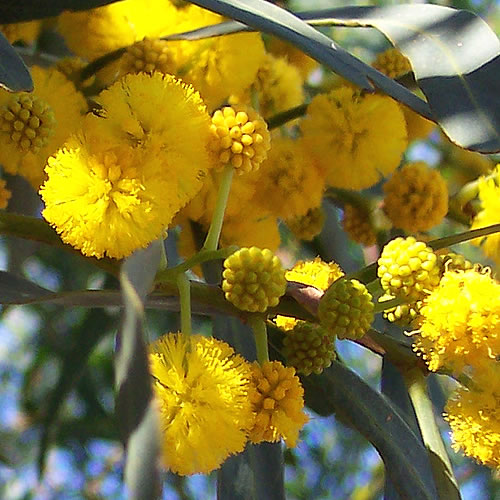 ACACIA (Acacia Senegal): Used to ward off evil, stimulates psychic powers when burned with sandalwood. Cape gum, Egyptian Thorn, Gum Arabic Tree, Kikwata. Food usesAcacia seed pods, also known as Guajes, served as part of a botana in Oaxaca, Mexico.
ACACIA (Acacia Senegal): Used to ward off evil, stimulates psychic powers when burned with sandalwood. Cape gum, Egyptian Thorn, Gum Arabic Tree, Kikwata. Food usesAcacia seed pods, also known as Guajes, served as part of a botana in Oaxaca, Mexico.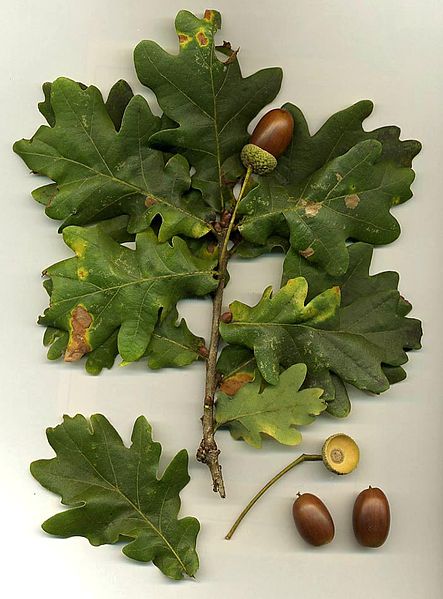 Acorns (Quercus Robur):
Acorns (Quercus Robur): 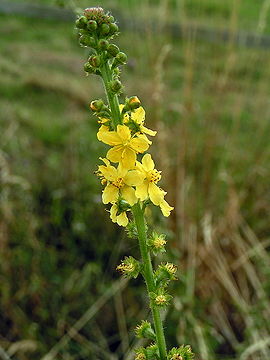 Agrimony (Agrimonia eupatoria): Used for protection, breaks hexes and sends them back to the hexer. Church Steeples, Cocklebur, Garclive, Philanthropous, Sticklewort, Stickwort, Umakhuthula, Ntola.
Agrimony (Agrimonia eupatoria): Used for protection, breaks hexes and sends them back to the hexer. Church Steeples, Cocklebur, Garclive, Philanthropous, Sticklewort, Stickwort, Umakhuthula, Ntola.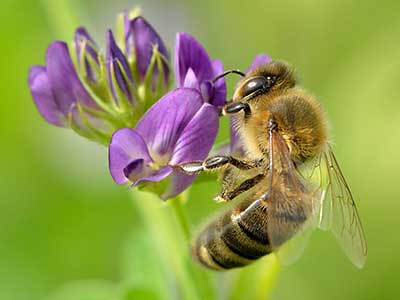 Alfalfa (Medicago sativa): also called lucerne, Buffalo Herb, Lucerne, Purple Medic, Jat, Quadb. Alfalfa is an herbaceous perennial that grows about two to three feet tall. From July through September, the plant bears bright purple or blue flowers followed by interesting corkscrew seedpods. The taproot is very long and tough allowing the plant to survive very dry weather. It also enables the plant to pull up nutrients from deep underground. Alfalfa fixes nitrogen in the soil and is often used during crop rotation for this purpose.
Alfalfa (Medicago sativa): also called lucerne, Buffalo Herb, Lucerne, Purple Medic, Jat, Quadb. Alfalfa is an herbaceous perennial that grows about two to three feet tall. From July through September, the plant bears bright purple or blue flowers followed by interesting corkscrew seedpods. The taproot is very long and tough allowing the plant to survive very dry weather. It also enables the plant to pull up nutrients from deep underground. Alfalfa fixes nitrogen in the soil and is often used during crop rotation for this purpose.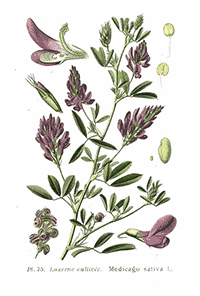
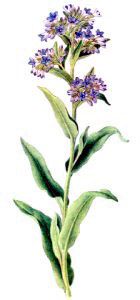 Alkanet (Anchusa officinalis) also called: Dyer's Bugloss, Orcanet, Dyer's Alkanet.: Burned as an incense to purify area of negativity, also attracts prosperity.
Alkanet (Anchusa officinalis) also called: Dyer's Bugloss, Orcanet, Dyer's Alkanet.: Burned as an incense to purify area of negativity, also attracts prosperity.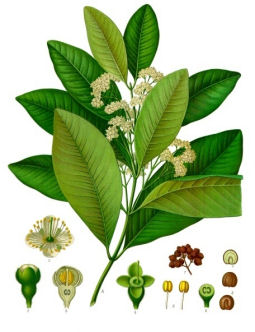 Allspice (Pimenta dioica): also called: Eddo, Madere, Basheen, Kouroubaga. Allspice comes from a tree in the myrtle family that grows in Central and South America. It is an evergreen which grows to about 30 feet (9 metres) tall and its glossy, aromatic green leaves reach about 6 inches in length. Small white flowers, and later the berries, green at first, then purplish-red, grow in clumps.
Allspice (Pimenta dioica): also called: Eddo, Madere, Basheen, Kouroubaga. Allspice comes from a tree in the myrtle family that grows in Central and South America. It is an evergreen which grows to about 30 feet (9 metres) tall and its glossy, aromatic green leaves reach about 6 inches in length. Small white flowers, and later the berries, green at first, then purplish-red, grow in clumps.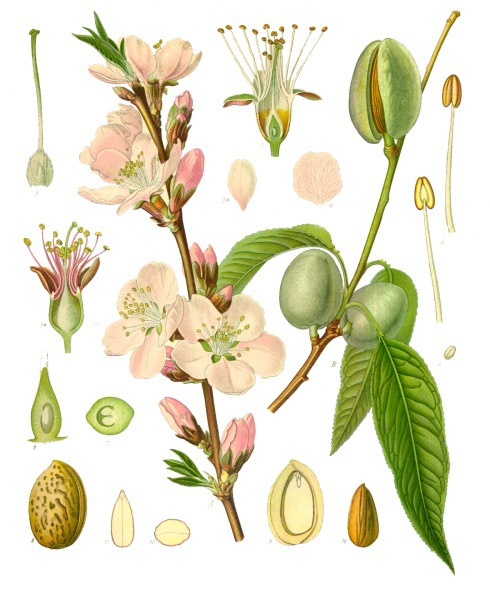 Almond (Prunus dulcis): Also called: Greek Nuts. The almond (Prunus dulcis, syn. Prunus amygdalus) is a species of tree native to the Middle East, the Indian subcontinent and North Africa.
Almond (Prunus dulcis): Also called: Greek Nuts. The almond (Prunus dulcis, syn. Prunus amygdalus) is a species of tree native to the Middle East, the Indian subcontinent and North Africa.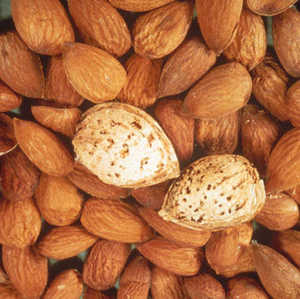 The fruit of the almond is a drupe, consisting of an outer hull and a hard shell with the seed, which is not a true nut, inside. Shelling almonds refers to removing the shell to reveal the seed. Almonds are sold shelled or unshelled. Blanched almonds are shelled almonds that have been treated with hot water to soften the seedcoat, which is then removed to reveal the white embryo.
The fruit of the almond is a drupe, consisting of an outer hull and a hard shell with the seed, which is not a true nut, inside. Shelling almonds refers to removing the shell to reveal the seed. Almonds are sold shelled or unshelled. Blanched almonds are shelled almonds that have been treated with hot water to soften the seedcoat, which is then removed to reveal the white embryo.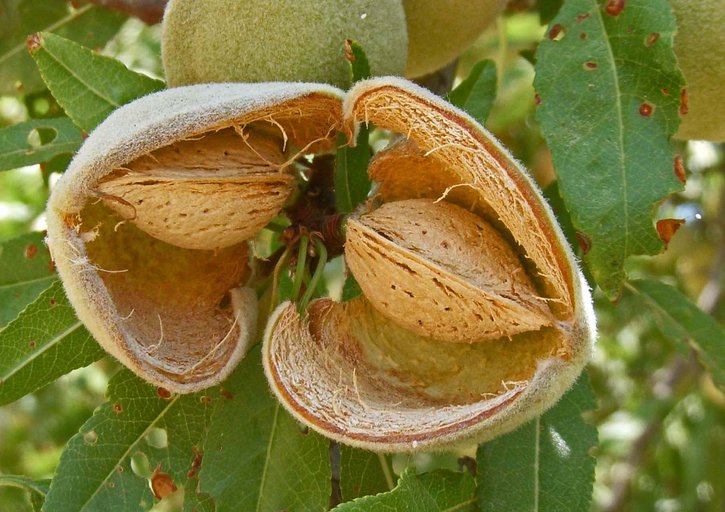 Used in prosperity and money spells. Eating will cure or combat fevers as well as giving wisdom. Almonds can be used in fertility charms worn by women to encourage the male seed to quicken within. Consider also using almond oil as an erotic massage oil for the same purpose.
Used in prosperity and money spells. Eating will cure or combat fevers as well as giving wisdom. Almonds can be used in fertility charms worn by women to encourage the male seed to quicken within. Consider also using almond oil as an erotic massage oil for the same purpose.